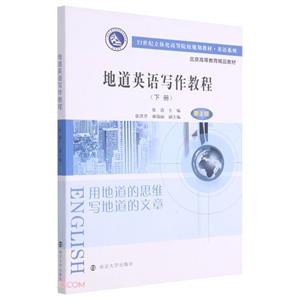-
>
闖進數學世界――探秘歷史名題
-
>
中醫基礎理論
-
>
當代中國政府與政治(新編21世紀公共管理系列教材)
-
>
高校軍事課教程
-
>
思想道德與法治(2021年版)
-
>
毛澤東思想和中國特色社會主義理論體系概論(2021年版)
-
>
中醫內科學·全國中醫藥行業高等教育“十四五”規劃教材
地道英語寫作教程.下冊(第2版)/張清/21世紀立體化高等院校規劃教材 版權信息
- ISBN:9787305171598
- 條形碼:9787305171598 ; 978-7-305-17159-8
- 裝幀:一般膠版紙
- 冊數:暫無
- 重量:暫無
- 所屬分類:>>
地道英語寫作教程.下冊(第2版)/張清/21世紀立體化高等院校規劃教材 內容簡介
在積累多年教學經驗的基礎上,根據教育部**制定的《大學英語教學指南》(征求意見稿)以及《英語類專業本科教學質量圍家標準》,為滿足學生專業學習、國際交流、繼續深造、工作就業等方面的需求以及現階段我國大學生在英語寫作巾所面臨的瓶頸問題,加強學生的書面表達能力,張清編寫了《地道英語寫作教程》(上、下冊)。 本冊是下冊,主要介紹應用寫作和應試寫作,包括第三部分和第四部分,共9個單元。第三部分為應用寫作,內容包括信件、大學入學申請材料、求職信、摘要和讀書報告:第四部分為應試寫作,內容包括大學英語四六級考試、英語專業四八級考試、研究生入學考試、托福考試、雅思考試等。本書理論和實用(實踐和應試)相結合,論述和豐富實例相結合。在中英對比的基礎上,充分分析英語寫作的特點;在詳盡介紹寫作要素和基奉文體寫作特點的基礎上,進一步分析實踐寫作和應試寫作的特點和注意事項。 本書既可以作為大學英語的公共課教材,也可以作為英語專業寫作課專用教材,還可以作為廣大英語愛好者的自學教材。
地道英語寫作教程.下冊(第2版)/張清/21世紀立體化高等院校規劃教材 目錄
10.1 General Introduction
10.1.1 The format ofaletter
10.1.2 The elementary parts of a letter
10.1.3 The optional parts of a business Letter
10.1.4 The layout of envelope
10.2 Personal Letters
10.2.1 A letter of invitation
10.2.2 A letter of thanks
10.2.3 A letter of consolation
10.2.4 A letter of congratulation
10.2.5 A letter of complaint
10.2.6 A letter of apology
10.3 Business Letters
10.3.1 Different types of business letters
10.3.2 Rules for effective business letters
Exercises
Unit Eleven College Application Writing
11.1 Requesting for Admission Form
11.1.1 General introduction
11.1.2 Structure of a requesting letter for admission form
11.1.3 Points to note
11.2 Graduation Certification and Notarization
11.2.1 Graduation certification
11.2.2 Graduation notarization
11.3 Personal Statement
11.3.1 General introduction
11.3.2 Significance of personal statements
11.3.3 Structure of a personal statement
11.3.4 Points to note
11.4 Letter of Recommendation
11.4.1 General introduction
11.4.2 Importance of recommendation letters
11.4.3 Structure of recommendation letters
11.4.4 Points to note
Exercises
Unit Twelve Employment Application Writing
12.1 General Introduction
12.1.1 Introduction
12.1.2 Preparation
12.2 Cover Letter Writing
12.2.1 Cover letter structure
12.2.2 The introductory paragraph statement
12.2.3 The body paragraph (s), highlighting your qualifications
12.2.4 The concluding part
12.3 Resume Writing
12.3.1 General introduction
12.3.2 Resume structure
12.3.3 Resume templates and samples
12.4 Supplementary Information
12.4.1 Tips for application writing
12.4.2 Resume checklist
12.4.3 Vocabulary about personality traits
Exercises
Unit Thirteen Summary and Reports
13.1 Summary
13.1.1 General introduction
13.1.2 Writing procedures
13.1.3 Principles in summary writing
13.2 Reports
13.2.1 General introduction
13.2.2 Book reports
13.2.3 Feasibility reports
13.2.4 Progress reports
13.2.5 The incident reports
Exercises
Unit Fourteen CET Writing
14.1 General Introduction
14.2 Scoring Standards
14.2.1 Principles for scoring
14.2.2 Standards of scoring
14.2.3 Case analysis on the scoring standards
14.3 CET Writing Skills
14.3.1 My view...
14.3.2 How to...
14.3.3 AandorB
14.3.4 Why...
14.3.5 Advantages or Disadvantages
14.3.6 Narrative composition
14.3.7 GraphChart composition
14.3.8 Practical composition
Exercises
Unit Fifteen Writing for TEM 4 and 8
15.1 General Introduction
15.2 General Scoring Standards
15.2.1 New types of writings of TEM 4 and TEM 8
15.2.2 TEM 4 and TEM 8 writing scoring standards of new types
15.3 TEMs Deduction of Scores
15.4 TEMs Scoring Analysis
15.4.1 Cases' analysis of TEM 4 scoring standards
15.4.2 Cases' analysis of TEM 8 scoring standards
15.5 TEMs Analysis:Irrelevance and Relevance
15.5.1 Material clues in TEM writing relevance
15.5.2 TEMs theme irrelevance
15.5.3 TEMs relevance analysis
Exercises
Unit Sixteen NETEM Writing
16.1 General Introduction
16.2 Scoring Standards
16.2.1 Official scoring standards
16.2.2 A case analysis of the official scoring standards
16.3 Writing Skills for Section A
16.4 Writing Skills for Section B
16.4.1 Format of the essay
16.4.2 Concrete analysis of the format
16.4.3 Useful sentence patterns for essay writing
Exercises
Unit Seventeen TOEFL Writing
17.1 An Introduction to the Writing Section of TOEFL IBT
17.1.1 The integrated writing task
17.1.2 Independent writing task
17.2 Scoring
- >
伊索寓言-世界文學名著典藏-全譯本
- >
經典常談
- >
朝聞道
- >
上帝之肋:男人的真實旅程
- >
史學評論
- >
有舍有得是人生
- >
回憶愛瑪儂
- >
中國人在烏蘇里邊疆區:歷史與人類學概述


















